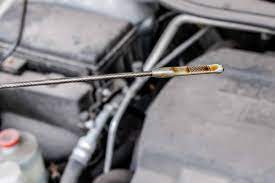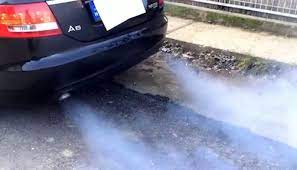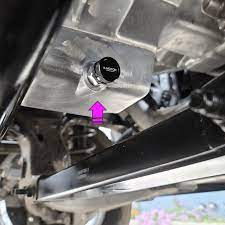What are the Risks of Too Much Oil in Your Engine and How Can You Fix It?
Realizing your oil level is low and you need to top it up seems like it would be a simple operation. And it can be, as long as you are able to be precise with what you are pouring. It is entirely possible to slightly overfill your oil reservoir.
There is some tolerance for over filling but if you exceed the maximum level by more that 0.2 on the dipstick you could be in for problems. Read on in this article to find out the problems you might face and what you can do to fix the issue before any damage is done.
What Happens if You Put Too Much Oil in Your Car?
This is a good question because you might think it’s a case of the more the merrier. This is not the case however as there are max limits for a reason. With too much oil in the system the crankshaft can hit the oil and cause it to foam while the engine is in operation. This can lead to engine damage over time.

If the oil is made foamy by the motion of the crankshaft the once lubricating fluid loses a great deal of its ability. The aerated oil will not pump as well through the system and over time it is almost as if you are low on oil. The parts will grind against one another because of the poor lubrication and can become damaged.
The oil reservoir is designed with some margin for error beyond the maximum fill taking into account fluid expansion in warm weather. This means you can likely get away with an extra half quart of over fill but definitely no more than that.
Consequences of Overfilling the Oil Reservoir
If you have too much oil in your car there will be a number of consequences including:
- Foamed Engine Oil – This causes the oil to lose its ability to work and to move more slowly around the engine.
- Combusted Oil – Engine oil is not supposed to be part of the combustion process in an engine but when overfilled the extra crankcase pressure can force oil into the combustion chambers. The result can be an alarming blue smoke from the exhaust.
- Spark Plug Fouling – It is important to keep spark plugs clean so that they can easily spark to initiate the combustion of fuel and oxygen in the engine's cylinders. Excess oil in the system can leak and find its way onto these spark plugs making them dirty and stopping the clean spark from occurring.
- Seals and Gaskets Failing – The oil system has a series of seals and gaskets designed to control the flow of the oil itself. Too much oil in the system can lead to high pressures damaging these seals and gaskets and as a result losing the functionality of the system.
Signals You Overfilled Your Car With Oil
If you filled up the reservoir yourself you should have checked the level using the dipstick. If it was markedly over max your first step should have been to remove some oil. If you didn’t check and your system is overfilled with oil then you may spot some of the following symptoms.
- Oil Leaks
- Smell of Burning Oil From the Engine
- Smoke From the Engine Bay
- Smoking From the Exhaust
- Overly Noisy Engine
- Engine Oil Pressure Light May Turn On

Is a Little Overfill Fine?
Earlier we did suggest that a little over the max fill level was okay but we should still point out that ideally you should not exceed the max line if you can help it. Different models of car will need different amounts of oil so if you are performing your own maintenance make sure you know your vehicle's limits and requirements.
If you have an older car you will find that they have a little more flexibility when it comes to oil levels but in newer vehicles you should really try and be accurate in your fill level.
What Can You Do To Fix an Overfill?
You just topped up the oil and having checked the dipstick you have noted you are way over the max level. This will need to be fixed straight away because you do not want to start driving around a great deal with this situation ongoing.
The only real fix for this is to drain out the excess oil which can be done in one of two ways. You can either use a suction pump or you can drain it out through the oil plug.
The easiest method by far is to drain the excess out through the oil plug as this requires minimal tools and no special equipment. There is an advantage with using the suction pump however as you will not have to raise your car and crawl underneath to perform this task.

In order to use the suction pump method you will have to have access to a suction pump with associated air supply. This is an expensive piece of equipment which you will not really find in the average home garage. The only reason the average Joe will own one is if they are really bad at refilling their oil.
So in all likelihood most people will opt for the oil plug method so we will now outline that for you below.
- Raise your car off the ground making sure it is safely supported by jacks and cannot move, roll or fall
- If there is an engine cover under the vehicle you will need to remove this before you start. Not all cars have this cover
- Locate the oil plug; you may want to refer to your owner manual or research your model of car online to help you with finding this.
- With a bucket lined up under the plug, remove it and allow the amount you think you overfilled to drain out before replacing the plug. Ensure the plug is correctly tightened.
- Refit the cover if you had to remove one and lower the vehicle back down.
- Start the engine and allow it to run for three minutes. This will distribute the oil around the engine and allow you to get a true reading of the new oil level.
- Wait 5 minutes before checking the oil to allow the engine to cool a little.
What If You’re Positive You Didn’t Overfill?
You might be right it is entirely possible that neither you or the oil change place overfilled your car with oil. Cars that are not driven far can develop an issue whereby fuel enters in with the oil and does not evaporate.
The reason for this lack of evaporation is that the oil does not get warm enough to heat the fuel within it. As a result it is not just oil but a certain amount of gasoline. You will likely require a complete oil change and you should also take some longer trips in the car to help the fuel evaporate going forward.
Conclusion
Over filling your car with oil can be problematic and do some serious damage to your engine. This is a simple fix as long as you catch the problem early. The longer you run with too much oil the greater risk there is of expensive damage.
Your car comes with a dipstick which allows you to measure the oil in your reservoir. Make use of this to ascertain that you have not overfilled it. If you suspect it was overfilled, also check with the dipstick.
Link To or Reference This Page
We spend a lot of time collecting, cleaning, merging, and formatting the data that is shown on the site to be as useful to you as possible.
If you found the data or information on this page useful in your research, please use the tool below to properly cite or reference Tow Ratings as the source. We appreciate your support!
-
<a href="http://towratings.net/blog/what-are-the-risks-of-too-much-oil-in-your-engine-and-how-can-you-fix-it/">What are the Risks of Too Much Oil in Your Engine and How Can You Fix It?</a>
-
"What are the Risks of Too Much Oil in Your Engine and How Can You Fix It?". Tow Ratings. Accessed on April 19, 2024. http://towratings.net/blog/what-are-the-risks-of-too-much-oil-in-your-engine-and-how-can-you-fix-it/.
-
"What are the Risks of Too Much Oil in Your Engine and How Can You Fix It?". Tow Ratings, http://towratings.net/blog/what-are-the-risks-of-too-much-oil-in-your-engine-and-how-can-you-fix-it/. Accessed 19 April, 2024
-
What are the Risks of Too Much Oil in Your Engine and How Can You Fix It?. Tow Ratings. Retrieved from http://towratings.net/blog/what-are-the-risks-of-too-much-oil-in-your-engine-and-how-can-you-fix-it/.